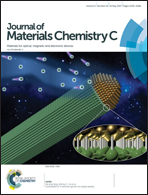Carbazole/oligofluorene end-capped hexanes: solution-processable host materials for phosphorescent organic light-emitting diodes†
Abstract
Alkyl substituents are promising in improving the solubility and film morphology of aromatic compounds for the solution processing of organic optoelectronic devices. However, the introduction of electronically inert alkyls will generally hinder hole and electron injection and transport into/between the aromatic units, leading to lower electronic properties of the material and thus inferior device performance. Here, we propose an alternative method by using alkyl groups via aromatic double end-capping alkylization, where aromatic carbazole and oligofluorenes were linked at both ends of a hexyl chain to obtain a series of carbazole/oligofluorene end-capped hexanes. These newly designed compounds show high solubility, good film morphology, high thermal stability, blue emission, high triplet energy, and suitable frontier orbital energy levels with good charge transport properties; when used as host materials in solution-processed phosphorescent organic light-emitting diodes (PhOLEDs), these molecules exhibit high device performance with maximum current efficiency of 28.0 cd A−1 and external quantum efficiency up to 7.8%. Our strategy of integrating both the advantages of alkyl and aromatic units offers an effective approach to design high-performance solution-processable organic optoelectronic materials.



 Please wait while we load your content...
Please wait while we load your content...